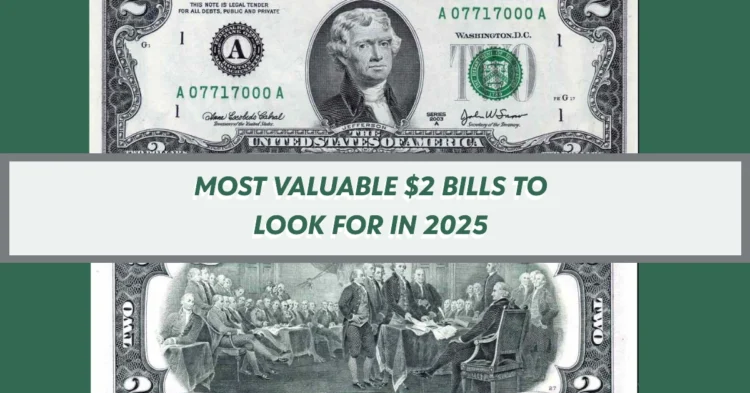The humble $2 bill, often seen as a novelty or collector’s item, is experiencing a major resurgence in 2025. Once overlooked, certain editions of this unique denomination are now being sold for hundreds—or even thousands—of dollars.
Whether you’re a serious collector or just curious about what’s in your wallet, here’s everything you need to know about the most valuable $2 bills circulating in 2025 and how to identify them.
Table of Contents
The Evolution of the $2 Bill
A Brief Historical Overview
- 1862: The U.S. government introduced the $2 bill as a Legal Tender Note featuring Alexander Hamilton.
- 1928: The bill was downsized to the familiar small note format.
- 1976: A commemorative redesign for the Bicentennial showcased Thomas Jefferson and the signing of the Declaration of Independence.
- 2003: The most recent series entered circulation but in limited print quantities.
Despite its historical value, the $2 bill has remained underused—making it ripe for discovery by collectors.
Why Are Some $2 Bills Worth So Much?
Several factors influence the collectibility and value of $2 bills in today’s market:
- Limited print runs in specific years or from certain Federal Reserve Banks
- Printing errors such as misalignments or ink flaws
- Star notes, which are replacement bills issued during the printing process
- Seal color differences between red U.S. Notes and green Federal Reserve Notes
- Fancy serial numbers that feature rare or symmetrical patterns
When these traits appear in combination—such as a star note with a printing error from a low-production year—the value increases significantly.
The Most Valuable $2 Bills to Look For in 2025
1. The 1976 Bicentennial Series
This iconic re-release features Thomas Jefferson and an engraving of the Declaration of Independence on the back. Bills in pristine condition, especially uncirculated or with consecutive serial numbers, can be valued between $10 and $500.
2. The 1890 “Mini Porthole” Large-Size Note
Nicknamed for its unique circular border design, this extremely rare note is a coveted prize. Professionally graded specimens have sold at auction for over $4,500.
3. The 1995 Series Star Notes
Particularly those issued by the San Francisco Federal Reserve Bank (indicated by a serial number beginning with “H”) are considered rare. Mint condition star notes from this series can fetch up to $200.
4. The 2003 Series $2 Bill
Modern but rare, especially in star note form from limited print runs. Mint condition bills are typically valued between $20 and $150.
5. Misprinted or Error Notes
Examples include offset printing, smudged ink, or misaligned serial numbers. A 1976 $2 bill with a significant print shift sold for $2,700 in 2024.
6. Star Notes from Older Series
Replacement bills from the 1928, 1953, and 1963 series are especially collectible. Their rarity and historical value place their worth well into the hundreds—or even thousands—of dollars.
7. Red Seal vs. Green Seal Notes
Red seals, used before 1976 on U.S. Notes, are less common than the modern green-sealed Federal Reserve Notes. A 1928 or 1953 red seal in great condition may be worth between $50 and $1,000.
8. Fancy Serial Numbers
Serial numbers with unique patterns significantly enhance a bill’s value. These include:
- Low numbers such as “00000001”
- Repeating sequences like “12121212”
- Palindromes like “12344321”
Bills with especially rare or artistic patterns can be worth up to $5,000.
Are 1,000-dollar bills worth a lot of money? Do you have one in your coin & currency collection?
USD/CAD Rally: Canadian Dollar Surges as Currency Pair Breaks Down Below Key 1.4000 Level
Dollar Tree to Exit US Market, Selling All Stores Due to Underwhelming Performance
Goodbye to This Dollar Bills at Bank of America: What You Need to Know About the Changes
How to Check If Your $2 Bill Is Valuable
Here’s what to examine when evaluating your $2 bill:
- Series Year: Focus on bills from 1928, 1953, 1963, 1976, 1995, and 2003.
- Star Symbols: Look for a small star at the end of the serial number.
- Seal Color: Red seals usually indicate older, rarer notes.
- Printing Errors: Misalignments, missing elements, or color issues increase value.
- Condition: Uncirculated bills—those with no folds, tears, or wear—are far more valuable.
Tips for Preserving High-Value $2 Bills
If you believe your bill may have collector value, protect it properly to preserve its worth:
- Storage: Use acid-free currency sleeves or holders to prevent degradation.
- Handling: Avoid direct skin contact; gloves are recommended for high-value notes.
- Environment: Keep bills in a dry, temperature-stable location away from sunlight.
Where to Sell or Appraise Rare $2 Bills
Whether you’re looking to sell or just get an expert opinion, these are your best options:
- Auction Houses: Trusted names include Heritage Auctions and Stack’s Bowers.
- Online Marketplaces: eBay and specialized collector forums like CoinTalk are popular platforms.
- Professional Grading Services: PCGS (Professional Coin Grading Service) and PMG (Paper Money Guaranty) provide authentication and valuation.
- Local Numismatic Shops: A reputable local dealer can offer insights and potentially buy your note on the spot.
Frequently Asked Questions
Are all $2 bills rare?
No. Most $2 bills still in circulation have standard collector value unless they have rare features or are in mint condition.
What defines an uncirculated $2 bill?
Uncirculated bills show no signs of handling—no folds, stains, or wear. They also retain original crispness and brightness.
Can I still spend a rare $2 bill?
Yes, but spending it at face value would be a mistake if it holds significant collector value.
Conclusion: Don’t Overlook the $2 Bill
While often dismissed as a novelty, the $2 bill holds surprising value in today’s collector market. From Bicentennial editions to error prints and star notes, your wallet could contain a piece of numismatic history.
Take a closer look—you might discover that one small bill is worth far more than its face value.

